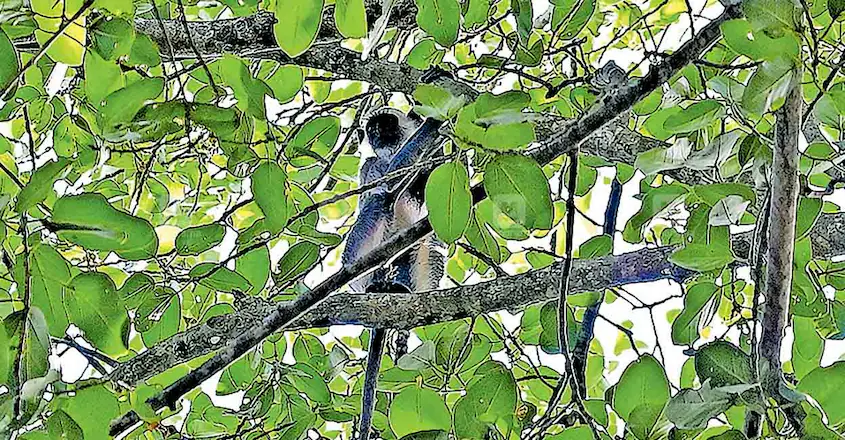Otherwise called the grey langur, the female that escaped was a part of a pair sent from a zoo in Tirupati as part of an exchange programme.

The escaped langur sitting atop a tree in the public library complex. (Supplied)
It seems that it was the heavy rain, which continues unabated across Kerala, that dashed the hopes of the Hanuman langur that escaped from Thiruvananthapuram, or Trivandrum, Zoo 24 days ago.
The female langur’s much-hyped field trip ended abruptly late evening on Thursday, 6 July, when she climbed down from a nearby coconut tree and entered one of the rooms at Goethe Zentrum, a German language school close to All India Radio office at Vazhuthacaud, looking for shelter from the monsoon showers.
Till then, she had never touched the ground — almost like she was playing a game of “The Floor is Lava” — and kept the zoo staff on their toes.
 Anticipating that the langur — an animal that is known for its inquisitiveness and intelligence — would enter one of the classrooms of the German school, two zookeepers left fruits inside the building as bait. As soon as the langur entered the classroom, the zookeepers closed the windows and the door of the room.
Anticipating that the langur — an animal that is known for its inquisitiveness and intelligence — would enter one of the classrooms of the German school, two zookeepers left fruits inside the building as bait. As soon as the langur entered the classroom, the zookeepers closed the windows and the door of the room.
Desperately looking for a way out, the primate headed to the bathroom and attempted to escape through its ventilation window, but it was in vain. The zookeepers quickly grabbed the langur’s tail and brought her under control with an animal catching net.
While this female langur is probably regretting her decision to enter the building, there are two people who are glad she did.
For Ajithan and Suji George, the zookeepers who were relentlessly following the langur for the past 10 days, her capture and return to the zoo had become a matter of prestige.
Despite the zoo authorities deciding to drop the search when the langur disappeared from public view eight days ago, the two continued their search and finally found her sitting atop a coconut tree in the German institute campus.
What provided them hope was the lack of any other big tree in the close vicinity for her to jump and again move away without even touching the ground. And the heavy rains contributed too!
Till about 5 pm on 6 July, if someone was seen craning their neck to look at Thiruvananthapuram’s treetops, they were assumed to be from the zoo, searching for the “fugitive” langur.
For nearly three-and-a-half weeks, this female langur kept the entire zoo staff engaged in an elaborate game of hide-and-seek across the city when she decided to emulate Queen and break free.
Until 6 July, she had the upper hand, occasionally appearing — albeit unexpectedly — on treetops to provide darshan to the citizens and perhaps get a closer look at the world below. But she would almost as quickly disappear into the foliage as the zoo authorities arrived with fruit baskets and a cage.
Zookeepers took turns to track the langur and place delicious bait close to the trees in which she was spotted, with the fond hope that hunger would find first preference.
The zoo authorities were not the only ones awaiting her return. Her escape left behind a rather lonely male grey langur.
It all began when a pair of grey langurs were brought to Thiruvananthapuram from the Sri Venkateswara Zoological Park in Tirupati, Andhra Pradesh, on 5 June — World Environment Day.
The pair was part of an urban troop that fed on garbage and food provided by the pilgrims visiting the Lord Venkateswara Swamy Temple. When the monkey menace became unbearable, the Tirupati Municipal Corporation trapped and handed them over to the local zoo two years ago.
The duo reached Thiruvananthapuram as part of an exchange programme. Around 3.30 pm on 13 June, the female escaped a few minutes after being shifted to a new enclosure.
The enclosures had undergone repairs and received a fresh coat of paint. The moat, too, had been repaired and filled with water to keep the animal inside. Tree branches had also been trimmed.
However, when released into the enclosure, the arboreal in captivity made a giant leap from one tree to another and fled in the general direction of neighbouring Nathancode.
Soon, she was spotted back in the zoo premises, perched on a tall tree. The authorities brought fruits and vegetables to lure her back into the enclosure. However, she didn’t fall into their trap, though she occasionally accepted food raised into the trees using ropes.
One rainy night, she left the zoo and took refuge on the trees in the Kerala Tourism Development Corporation’s Mascot Hotel campus before deciding to tour the city. She jumped into the adjacent Church of South India (CSI) cemetery and Bains Compound, before heading to the Connemara Market at Palayam.
Since she wasn’t too keen on shopping, she didn’t remain in the market for long. She was soon spotted close to the Public Works Department office complex near Vellayambalam.
Thiruvananthapuram city has a robust green cover, thanks to the former Travancore royals. The trees, which typically add to the city’s charm, became redoubts for the furry fugitive.
Throughout her city tour, the langur graciously accepted bananas the zoo staff raised to the trees. On 21 June, she appeared atop a banyan tree on the State Central Library campus.
The library’s newest visitor preferred the banyan figs, a decent meal of bananas, and a tender coconut over the books in the library but it did not stop her from seeking refuge before finally coming out of hiding.
Eventually, she was tracked to her final resting spot, the German institute.
The zoo authorities believe that the langur is healthy and safe, and zoo director Alexander Jacob also conducted a preliminary check on her after her return. An anti-rabies vaccination was administered on Friday, 7 July, before releasing her back into the enclosure.
As per the prevailing rules, darting monkeys is illegal as it would affect their health and sustenance. So the proposal to dart it was also abandoned.
Unlike rhesus or bonnet macaques, the langur prefers to stay high on treetops surrounded by a towering green canopy.
Though the escaped monkey created a sensation in the city, she never entered dwellings or pilfered food to satisfy her cravings. She was also identified as less aggressive.
A member of the zoo staff told South First that the langur was released into the enclosure as a trial ahead of an event in which both langurs would be formally released for display to visitors.
Along with the langurs, a pair of lions, and a pair of emu were also brought in exchange for hyenas and hog deer. Kerala Minister for Livestock and Zoos J Chinchu Rani was to name the lions and monkeys at the function before releasing the animals into their separate enclosures.
Monkeys have escaped from the zoo before, but they always return, explained zoo officials. However, they added that this langur’s unfamiliarity with the area might have turned out to be a hurdle in her return. A monkey had last escaped from the zoo in February.
“We captured the target finally by constantly tracking its movement and pursuing numerous leads in which a majority were false. The langur will be in isolation in a separate enclosure for two weeks while it is under observation. Then, we will release it to the original enclosure with its pair,” informed the zoo director.
And thus ended this Hanuman langur’s expensive jaunt across Thiruvananthapuram, clinging on to her last few days of freedom.

May 04, 2024

May 03, 2024

May 03, 2024

May 03, 2024

May 03, 2024

May 03, 2024